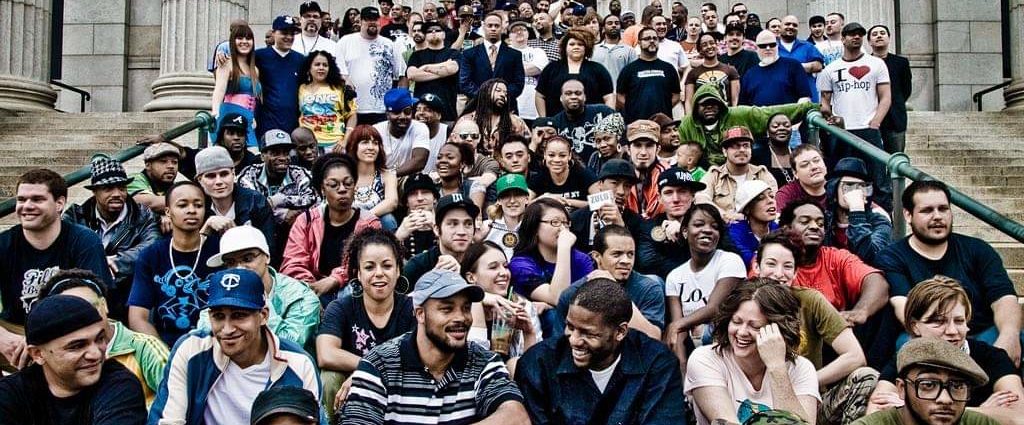Three photos, now part of the Minnesota History Center collection, celebrate the contributions of the first generations of hip hop culture.
WORDS BY KATIE DOHMAN
This is a tale of five photos.
The first is Art Kane’s 1958 photo, A Great Day in Harlem, which appeared in Esquire magazine in 1959 and featured nearly 60 jazz musicians spilling off the steps of a brownstone in Harlem.
When Ryan “DJ Stage One” Dillard first saw famed photographer Kane’s photograph, he saw camaraderie. Some of the faces he recognized from his parents’ record collection. Others were a mystery. “It’s a powerful picture. I was intrigued. . . it definitely formed a curiosity in my mind as to why they were standing there, what it was about,” Dillard says.
The second photo is Gordon Parks’s 1998 photo, A Great Day in Hip Hop, which was an homage to Kane’s work, and features 177 hip hop artists and influencers on the same brownstone stoop as the original and appeared on the cover of XXL magazine. Hip hop as a cultural practice was just over drinking age, but it had arrived mainstream, countering the prevailing claims that it was just a fad—or worse. It was a stand on those Harlem steps.
Those photos, and what they stood for, stuck with Dillard, who grew up in the ’80s and ’90s in Minneapolis amid the explosive growth of hip hop culture. By turns, the 50-year-old Dillard—the same age as hip hop, this summer—has been a DJ, graffiti artist, author, hip hop historian, and activist.
His mix of experience birthed the idea for the third photo in 2010: the Minneapolis–based tribute photo, A Great Day in Twin Cities Hip Hop. It was time to give props where props were due, he says. He gathered members of the hip hop community, photographer Uche Iroegbu, and journalist and filmmaker Ralph Crowder III, who shot film that day.
“We built something from nothing through the years,” he says. “It’s been fun, but there have been a lot of hurdles…we were pushed into the dark and house parties and underground,” he says, citing how club owners denied performance opportunities because they needed “extra security” or how school systems opposed their art, or law enforcement busted up lawful parties. “But now hip hop is able to spread its wings into the forefront of this community…it’s gone commercial but it still has an underground edge.”
It’s also about that, for a time, Minneapolis-St. Paul hip hop was a small community looking outward, but now hip hop community members worldwide know how to pronounce Minneapolis; that at one time, they couldn’t feed or house people, but now their art, and their influence, does.
And, he knew how easily the power of the people and movements can fade. “People influence communities and then go into obscurity without anyone letting them know how much they respected what they did,” he says.
“The photo shoot is a forever piece that everybody can celebrate,” he continues. “[People can look and say] ‘That’s me right there. I’m a part of this fabric and foundation of a culture that started from nothing.’”
Then came photos four and five: Dillard and a team of photographers and hip hop community members recreated the photos again, in 2015 and 2021, taken by Keegan Xavi and Ben Kressel, respectively. The numbers, and the diverse faces, tell a story of the growth of the hip hop community here over time.
“We went from being a stereotypical group of teens from certain racial background to now everybody is doing it,” he says, noting there are issues within the community that have room for improvement. Still, the progress is undeniable. “We went from getting no respect to where the culture has respect and community at large understands the power of how hip hop can bring people together and educate and all those things, and hip hop as a culture is there to see it through to help with the progression of the artists of tomorrow.”
Dillard reiterates hip hop is here “thanks to the merits of youth culture, who fought the whole way.” But that youth is approaching 50, a tenuous age that’s simultaneously young for a culture but old enough to look back. It’s time for the youth culture of the past who got hip hop here to become the standardbearers: Honor your elders, but try new things and support the youth of today.
“Art that’s taking chances, that’s different from norm—that’s the art of tomorrow,” he says. “That’s the art that sets the trend.”
The three photos, which have since been donated to the Minnesota History Center, serve multiple purposes, chief among them the respect due to those who built this culture, making sure their contributions are noted in the historical record, and that their art meant something, that others need to know it, too.
And even if the viewer isn’t familiar with the faces in these three photos, perhaps it will ignite the same curiosity, empathy, or understanding—based on the looks of excitement, power, and accomplishment the subjects have—that Dillard once felt seeing Kane and Parks’s photos.
“These are all artists who respect the art form and culture,” he explains. “They’re good people who love what they do and love hip hop culture . . . We should give recognition for them changing the environment through music, art, painting, and dance. If nothing else, the photo series is a bunch of expressionistic people who are serious about their craft. They’re loving what they do and spreading love to others peacefully. It’s a beautiful thing.”
WHEN YOU GO
A Great Day in Twin Cities Hip Hop screening and discussion
View the documentary, see the photos and other memorabilia, hear live music, and listen to a panel discussion of local hip hop notables.
March 4, 2-4 PM
Minnesota History Center, 345 W. Kellogg Blvd., St. Paul, mnhs.org

